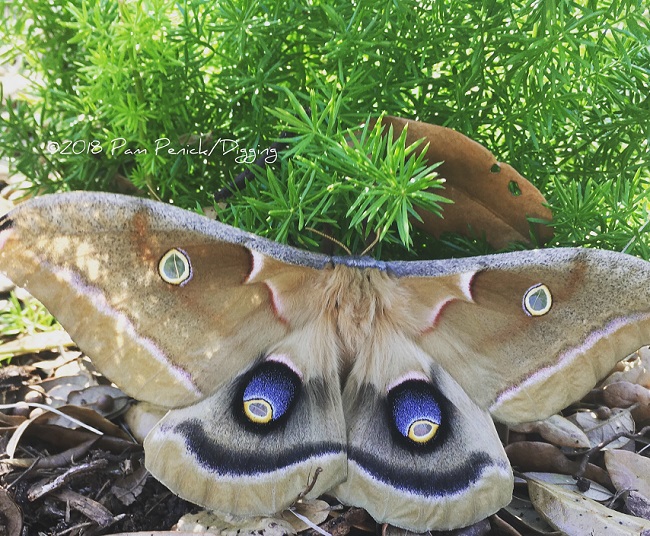Bonnie bluebonnets and a polyphemus moth
Who knew a patch of bluebonnets (Lupinus texensis) by the front door could bring so much joy? Well, probably lots of Texans. It is our state flower, and we all take pictures of our kids and dogs sitting in fields of them every spring.
My own personal “field” of 3 or 4 plants grew from seed that washed into the gravelly space between driveway and front walk, from bluebonnets (or their descendants) grown in a raised bed across the driveway years ago.
We have to step over them every time we enter or leave the house. But I don’t mind. It’s worth it for these bonnie blues.
Unrelated to the bluebonnets, but equally welcome in my garden, is this polyphemus moth — named, for its striking, eye-like spots, after the cyclops of Greek myth (although he had only one eye, of course). Those “eyes” startled me when it gave a brief wing flutter from its hangout on a foxtail fern at ground level. The thing was nearly as large as my hand, and furry as a rabbit.
This is the great thing about having a garden. You never know when something of beauty will drop into your lap. But you know it will happen.
I welcome your comments; please scroll to the end of this post to leave one. If you’re reading this in a subscription email, click here to visit Digging and find the comment box at the end of each post.
_______________________
Digging Deeper: News and Upcoming Events
Join the mailing list for Garden Spark Talks! Inspired by the idea of house concerts, I’m hosting a series of garden talks by inspiring designers and authors out of my home. Talks are limited-attendance events and generally sell out within just a few days, so join the Garden Spark email list for early notifications. Simply click this link and ask to be added.
All material © 2006-2018 by Pam Penick for Digging. Unauthorized reproduction prohibited.






This is the time of year (or one of many) when I truly envy my southern-gardener friends. I’m still salivating over my snowdrops and a few early crocuses. Will the bluebonnets still be abloom at the end of the month for our Fling?
Unfortunately, no, although we might see a few hangers-on at the Wildflower Center. Bluebonnets are one of our early wildflowers. But you’ll see plenty of other wildflowers that like it a little hotter, so never fear! —Pam
What a great photo of the moth! How lucky you were to capture its beauty at that very moment. I must spend more time sitting quietly in my garden!
That’s always a fine goal, and one of mine as well. However, at the time I spotted the moth, I was planting a plant right in front of it, and that’s when it startled me by moving its wings.
BTW, your blog link was bad, so I fixed it. 🙂
That moth is incredible! And how wonderful that it’s color-coordinated with your beautiful lupines.
That WAS clever of it, wasn’t it? —Pam
I’m thinking the caterpillars must be sizable? Off to look up what they eat…
They must be. The moth’s body was HUGE. —Pam
The caterpillars do get big: to three inches by their last instar, and a showy acid green. They eat the foliage of a wide range of trees, so a female can fairly easily find a good spot to lay eggs.
And that’s a good thing, because the moths only live for a *week*. Makes your shot even more of a marvel!
It sounds like they hang out up in the tree canopy, so it’s probably not likely I’ll run into one. I feel lucky to have seen the moth, even though I read they are quite common. —Pam
One more fun fact: the pattern, designed to startle away predators (pretty crucial when you have only a week in which to mate and lay eggs), resembles the eyes of the great horned owl. Doesn’t it? So cool.
To me it looks more like eyes on stalks, like a crab — Tamatoa, to be exact. They are startling. —Pam
Turn the picture upside down to see the owl illusion, I forgot to say.
You have two beauties just showing up in your garden. Lovely!
I’m enjoying them. 🙂 —Pam